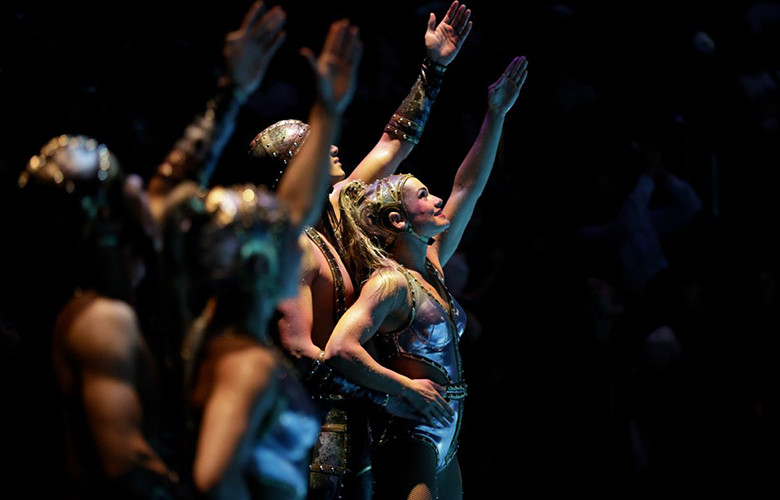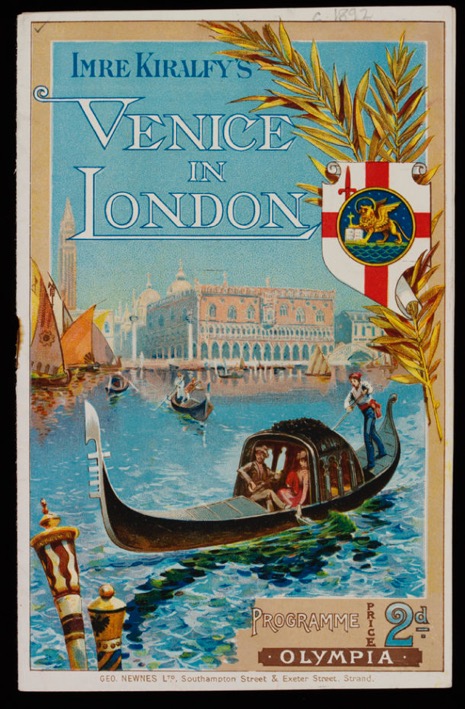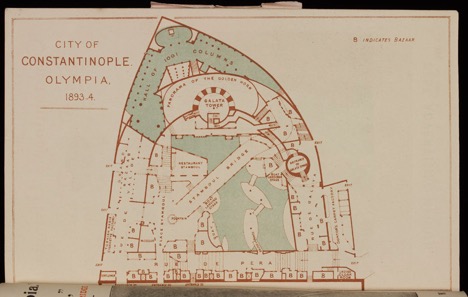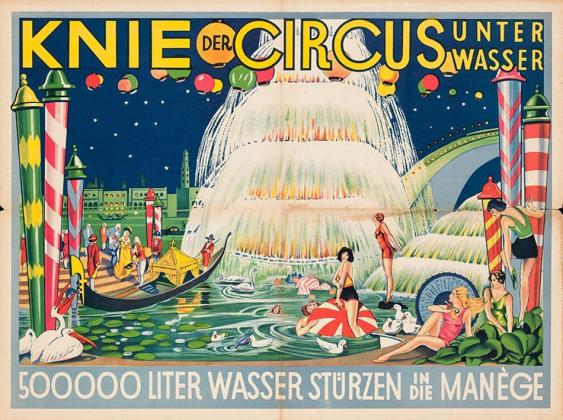
‘O’ by Cirque du Soleil is one of the greatest entertainment marvels of our time. It is a water-themed (aquatic) stage production by Cirque du Soleil, created by Franco Dragone. ‘O’ was the first aquatic circus show in Las Vegas. It opened at the Bellagio in October 1998 and has been sold out ever since. Its 10,000th performance was on September 1, 2019.
‘Le Reve’, another aquatic circus marvel (also created by Franco Dragone, this time for his own company, Dragone Entertainment) opened only a few years later, in May 2005, at the Wynn in Las Vegas. It celebrated its 6,000th performance in May 2016 and is also still going strong.
A contemporary aquatic circus show doesn’t involve animals, but rather acrobatic performers, dancers, etc. onstage. Aquatic theatres usually hide a pool under their, at first sight, deceptively dry stage. The stage floor is comprised of several independently moving lifts, enabling the creators of the show to present ever-changing landscapes of either a fully dry stage, a partly dry stage, or splashing water only inches deep. Or, the entire stage can transform into one body of water of various depths, from which anything can emerge. There might be geysers, jets, fountains of all sizes, rain, or even waterfalls.
The show will begin and, at some point, the stage floor will move silently into the depths. This is when performers as well as props will magically appear or wondrously disappear beneath the water surface. You will see millions of gentle bubbles or, at times, the water might actually seem to be boiling. Lighting effects from above and below the water will transform this unique theatrical space moment by moment. The entire stage will resemble a living and breathing organism.
Added to the many – already by themselves dazzling – acrobatic circus acts, the water itself becomes a performer. Its presence is powerful. Its scent lingers in the air. Your body will respond to the microscopic, ever-present mist in the air with a form of primal excitement. Even just sitting in the house, waiting for the show to begin is invigorating.
Every time I step into an aquatic theatre auditorium, long before any performance or rehearsal even starts, my nostrils open wide as I inhale the scent of mildly chlorinated pool water. A satisfied, happy smile spreads all over my face as my entire body begins to tingle with anticipation.
Now, imagine this elation and off we go, the show begins, bringing you traditional and contemporary circus elements like straps, Russian swings, trapeze, etc. which further give you goosebumps and have you at the edge of your seat. For the remainder of the performance, you’ll be a traveler, far away from the reality of your every-day existence.
As I began working for ‘The House of Dancing Water’ – yet another aquatic Franco Dragone creation – in 2010, I was fascinated by the vision of adding water to the performing arts. Especially on a scale as large as in this brand-new venue in the ‘City of Dreams’ casino complex in Macau. “Incredible what modern technology enables us to do,” I thought.
Imagine my surprise when I discovered that aquatic shows per se had been around for a long time. Sure, modern technology allowed us to go grander and splashier than ever before, but the first aquatic circus acts were presented in the year…
It all began in France, when Joseph Oller’s ‘Nouveau Cirque’ opened in Paris. It was an aquatic sensation. The arena could be lowered by a hydraulic system to create a water basin for aquatic performances. “Oller’s ‘Nouveau Cirque’ was notable for its hydraulically powered movable floor that could sink slowly, fill with water and become transformed into a swimming pool deep enough for diving. With arc lights illuminating the artificial lake, acrobats performed an aquatic burlesque.”
In England, aquatic shows were born in Victorian circus. Hengler’s Circus in Argyll Street, near London’s Oxford Circus, the site of the London Palladium, presented their first Grand Water Pantomime to amazed audiences between December 1890 and April 1891. Their posters announced the ‘Great Real Water Spectacle’ – “23,000 gallons of real water poured into the arena in the incredibly short time of 35 seconds.”
In the final scene, the circus ring was transformed into a lake, with bridges, performers on wooden boats and even a small flock of temperamental ducks flapping their wings.
Still more astounding, in the same year, audiences had the choice between two water shows in London. The second show, ‘George Sanger’s Great Water Carnival’, premiered in the Amphitheatre at Westminster Bridge Road after Boxing Day 1890. It was considerably larger than Hengler’s circus and presented a ring flooded by 80,000 gallons of water. Clowns could be seen, as well as steamers and boats. Instead of ducks, Sanger opted for geese and swans.
The following year, in 1891, Sanger went a step further with his pantomime ‘The Jockey Club’, featuring a “Grand Cataract of Real Water” and action-laden performances, including capsized boats, submerged occupants, and the main character falling off a bridge into the lake beneath. (This a scene which eerily reminds me of yet another magnificent scene, featuring a bridge and a different main character falling off of it into the lake, then submerging… 119 years later, at ‘The House of Dancing Water’ in Macau.)
According to Albert Hengler, he had already dreamed of aquatic shows long before 1890, yet “his father and uncle had laughed at his idea of a flooded circus arena”. Thus, when his father died Albert put all his energy into the ‘water novelties’, which according to a statement he made to the press at the time, were a blazing success, bringing him revenue like never before.
However, at the time these two creators were competing against each other, they were outperformed by a project of gigantic proportions:
In 1891, the biggest and most profitable aquatic extravaganza in London opened after Christmas, at the Olympia Exhibition Hall. Joseph Lyons and Harold Hartley brought Venice to London, complete with canals, facsimiles of buildings, and gondoliers. The Grand Aquatic Carnival Ballet with a thousand (!) dancers and a breathtaking Aquatic Pageant performed four times a day. Imre Kiralfy’s ‘Venice in London’ ran for over a year and cost an absolute fortune at the time. However, a never-ending flood of enthused spectators stormed the exhibition hall and all expenses were paid for after only three months.

‘The Times’ spoke of “by far the most important spectacle of its kind ever witnessed in London”, and ‘The Graphic’ called the aquatic experience “Wonderfully Gorgeous, Simply Bewildering.”
In 1893, the Olympia Exhibition Halls were sold to a new company. However, the expensive Venetian canal installations were kept for a second season. Imre Kiralfy’s brother Bolossy took over the production and transformed the existing settings into ‘Constantinople’. This new vision included the show “Grand Terpsichorean, Romantic and Lyric Spectacle and Aquatic Pageant in Two Acts and Six Tableaux” (quite a mouthful), as well as golden domed buildings, mirrored halls, and Arab-inspired row boats.

Opening day was attended by over 32,000 people. The show ran for two years, until November 1894. This was followed straight after, in December 1894, by yet another aquatic spectacle created by Bolossy Kiralfy, called “The Orient”. Unfortunately, a flu epidemic at the time forced the highly successful show to close its doors seven months later, in July 1895.
In 1894, Frank Matcham re-designed the Blackpool Tower Circus building on the Irish Sea coast of England to accommodate aquatic special effects. The building resembled the Eiffel Tower, with the circus arena nestled within.
The venue is still in operation today. Its circus shows offer a wonderful nostalgic ambience throughout. The icing on the cake, however… or rather… the droplets on the dazzling surface are when jets around the circus ring fill the arena with water for the stunning aquatic finale.
In 1899, the London Hippodrome near Leicester Square broke new ground in aquatic theatre architecture, technology, and design. Theatre architect Frank Matcham offered the expertise from his previous project and was given responsibility for the bold venture. As happens for all purpose-built aquatic theatres I’ve ever heard of, the planned opening in Christmas 1899 was “unavoidably delayed owing to the mechanical stage and arena requiring protracted rehearsals.”
“The auditorium featured a stage in-the-round containing a tank 230 feet in circumference operated by hydraulic rams. The tank featured fourteen port lights, eight telescopic central fountains and a circle of fountains around the ring fence. The stage sank to the depth of 8 foot in about a minute and was filled with 100,000 gallons of water weighing 400 tons, for spectacles such as ‘The Grand Spectacular Aquatic Carnival’ or the ‘The Absent-Minded Millionaire”, its opening aquatic production in which the young Charlie Chaplin took part.”
The London Hippodrome was celebrated as a modern wonder. It opened its doors to the eagerly awaiting public on January 15th, 1900.
For the next ten years, the London Hippodrome presented a multitude of aquatic productions to the public. Many of these shows had originally been produced by Albert Hengler whose aquatic shows had stopped performing in his own circus by 1895, after he had leased his venue permanently to the National Skating Association who had turned “real water” into “real ice.”
Speaking of ice, in 1901, Hengler’s show ‘The North Pole’ at the London Hippodrome even attempted realistic snow and ice in the arena with polar bears playing in the water.
In 1903, ‘The Redskins’ featured horses and soldiers plunging into a river and Indians in canoes paddling away as fast as they could.
In addition to lending his extensive aquatic experiences and imagination to the London Hippodrome, Hengler still owned aquatic circuses in Birmingham, Glasgow, and Manchester. Sadly, in 1904, he finally pushed his creative vision a bit too far and had to declare bankruptcy in Manchester.
Nevertheless, Hengler’s productions were as popular as ever. And one of them, ‘Siberia’, even performed at the Nouveau Cirque in Paris in 1905, coming full circle to the stage where the magic of and fascination with aquatic shows had begun.
The London Hippodrome aquatic shows closed in 1909 to give way to concerts and theatre performances instead. Unfortunately, the beautiful venue was demolished in 1958.
In Norfolk, England, yet another Hippodrome opened in 1903. In the first few years, this venue hosted a whole array of circus spectacles, including aquatic shows as well. This was followed by many years of “dry” circus shows. But then, “Peter Jay restored the water spectacle for his first produced circus show in 1981, having bought the building in 1979. The water has been a major part of their unique shows ever since.”
Today, the Great Yarmouth Circus’s aquatic shows in the historic Norfolk Hippodrome are still being performed on a daily basis. This Hippodrome is the only remaining purpose-built circus building in Britain.
According to circus historian Sabrina Offord, “Being within the original 1903 building and seeing the sinking ring flooding for an aquatic spectacle that lasts the entire second act is an unforgettable and magical experience – a time machine with modern lighting that links you to the past and has to be seen to be believed.”
Over the years, aquatic circus shows made their way to other European countries as well. Let’s have a look at Germany and Switzerland.
Germany’s Zirkus Busch is famous for its water extravaganzas which were first introduced in Hamburg in 1904. Paul Busch had bought ‘Zirkusbau Renz’, an old circus building. He converted the original octagonal ring into a round pool which could hold 600 cubic meters of water. The pool was covered by a ring floor weighing 18,000 kilograms. This floor could be lowered to 4 meters depth. Zirkus Busch performed wonderful productions in their aquatic theatre-in-the-round. “One of the most famous of later years, in 1918, premiered in Berlin during World War I. It was called “The Sunken City”, based on the ‘Vineta Legend’, directed by Paula Busch… a sensation combining romantic magic with technical miracles…”
Paula Busch remembers, “Each night, 30,000 liters of river water plummeted from the circus cupola down onto the sinful town of ‘Vineta’ on stage. 50 performers and 27 animals were swallowed by the flood. The storm lasted 6 minutes… Our ‘miracles’ consisted of diving bells which we had installed in strategic corners in the pool to provide men and beast with breathable air underwater. This called for plenty of courage from all players, to trust being confined in these iron tombs, submerged underwater, in closest quarters with wild circus cats, goats, and pigs, …”
In 1934, the Swiss Zirkus Knie invited Zirkus Busch to tour with them through Switzerland for the duration of their season. Against the protests and financial worries of his brothers, Karl Knie insisted and rented Busch’s famous Water Pantomime. He proceeded to spend a fortune to, for just a few months, turn the Zirkus Knie arena into an aquatic theatre. Against all odds, this proved to be a smashing success, audiences practically falling over each other to be able to snatch a seat in the arena. The temporary setup featured a pool, a huge fountain on stage and 500,000 liters of water.

Possibly because of all the turbulence and hardship caused by World War II, the obsession with aquatic circus performances waned worldwide. Aquatic shows soon became all but forgotten. People had neither money nor time to spend for such exotic spectacles anymore. Thus, the aquatic circus disappeared, just as Atlantis had once vanished.
Until Franco Dragone resurrected the forgotten aquatic world. In a brilliant manner, he raised Atlantis and brought aquatic shows back to the international, contemporary circus arena. Technology was on his side, making it possible to build entirely new worlds on stage, creating grander aquatic landscapes with a complexity and beauty like never before possible.
‘O’, ‘Le Reve’, ‘The House of Dancing Water’, ‘The Han Show’, ‘La Perle’, and a couple other shows he has created in Asia have entered the entertainment market with a mighty splash. And, for now, it seems they are here to stay.
As mentioned in the beginning of this article, Cirque du Soleil’s ‘O’ has now performed to a full house for 22 years with no signs of slowing down. Dragone’s ‘Le Reve’ has performed for 15 years. His iconic ‘The House of Dancing Water’ has already performed successfully for a decade as well.
There is one other, smaller player currently making a splash.
In 2012, Cirque Italia was founded. As the name partly suggests, it is an Italian entertainment company. Furthermore, it is an aquatic circus company. In contrast to Dragone’s productions however, Cirque Italia tours the world with its custom-designed water stage. As stated on their website, “Cirque Italia presents ‘Aquatic Spectacular’. The name reflects a unique attribute under the tent, as the show features a custom designed water stage that travels from city to city. The stage holds 35,000 gallons of water that performers dazzle over while thrilling the audience with every move.”
For us human beings, the fascination and deep connection with water is part of our very nature. Thus, water on stage will never lose its appeal. Death-defying performances, beautiful choreographies, colorful imaginative worlds, uplifting fairy-tale stories, and pearls of water reflecting dazzling lights.
The exhilarating blend is irresistible.
Don’t Wear That Hat: Theatre Superstitions & their Origins
Under the Big Top with Zirkus Knie: Birth of A Passion


Liam Klenk was born in Central Europe and has since lived on four continents. Liam has always been engaged in creative pursuits, ranging from photography and graphic design, to writing short stories and poetry, to working in theatre and shows. In 2016, Liam published his first book and memoir, 'Paralian'.
Read Full Profile© 2021 TheatreArtLife. All rights reserved.

Thank you so much for reading, but you have now reached your free article limit for this month.
Our contributors are currently writing more articles for you to enjoy.
To keep reading, all you have to do is become a subscriber and then you can read unlimited articles anytime.
Your investment will help us continue to ignite connections across the globe in live entertainment and build this community for industry professionals.